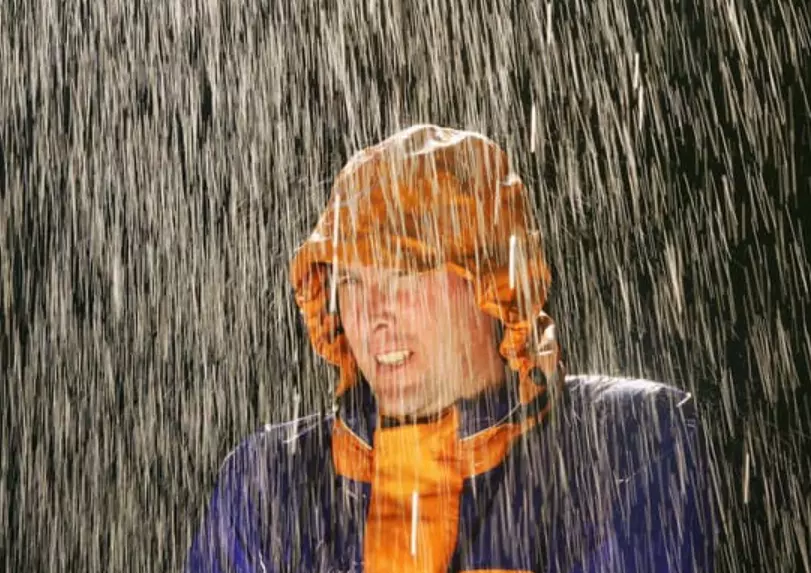Keeping your clothes dry while camping can be a serious challenge. We’ve all been there! At the end of a long hike your shirt is drenched in sweat, you get caught in a rainstorm, cross a river/stream, or need to wash your clothes. There are dozens of reasons why you may end up with wet clothes while camping and backpacking. There’s no way to avoid it! How do you dry clothes when camping?
There’s no easy way to dry your clothes on a camping trip, but you can speed up the drying process. Take advantage of sunlight to dry wet clothes and stick to quick drying moisture-wicking clothing. That will speed up your drying time and keep your clothes dry on long hikes. Unfortunately, sometimes you won’t be able to avoid water so you’ll have to hang your clothes to dry in the sun. Once your clothes get wet, wring out the excess moisture, and hang them up on tent guy lines, tree branches or a makeshift clothesline to dry in the sun.
If you follow all of the above tips it shouldn’t take longer than 30 minutes to an hour to dry your clothes on a sunny day. Unfortunately, we don’t always get sunshine so you’ll have to make adjustments in rainy/snowy weather!
In the rest of this post I’ll explain how to keep your clothes dry on a camping trip, dry off wet clothes, and teach you how to dry clothes on rainy or snowy days. By the end of this post you shouldn’t have to worry about getting your clothes wet. This is a ridiculously long guide so you might want to use the table of contents to skip around.
Table Of Contents
How To Dry Wet Clothes When Camping
We all love camping in warm sunny weather, but unfortunately we don’t live in a perfect world. When you have to make campsite reservations and pull backpacking permits months in advance there’s no way to predict the weather.
Rain is the most likely cause of wet clothes while camping, but it’s almost impossible to stay completely dry over a long camping or backpacking trip. You also run into issues at river/creek crossings, sweat buildup, condensation, washing clothes, etc. There are dozens of reasons why my clothes have gotten wet over the past couple of decades I’ve spent camping.
There’s no way to completely protect your clothes/gear from water. That’s why it’s important to have a plan in place so you can dry wet clothes while camping or backpacking. How do you dry wet camping clothes?
- Choose Moisture Wicking Clothes: Never wear cotton or denim on a hike! They trap moisture and take forever to dry. Moisture-Wicking clothes are a much better option. Moisture wicking clothes are designed to speed up the evaporation of sweat, rain, condensation, etc. You have two main options: technical sports fabrics and merino wool. Merino wool doesn’t seem like a good for hiking, but it can absorb up to 35% of it’s weight in water without feeling wet and it’s comfortable in both warm/cold weather.
- Use Wind and Sunlight To Dry Clothes Fast: The sun is the most powerful heat source on the planet. Hanging up moisture-wicking clothes in direct sunlight will dry them off in 30 minutes to an hour. It might take a little bit longer on overcast days, but they should still dry in a reasonable amount of time. Wind also plays an important factor when it comes to drying time. Hang up your clothes high and try to maximize the breeze to take advantage of wind gusts.
- Hang Wet Clothes On Tents, Guylines, Clotheslines, and Tree Branches: I like to hang up my wet clothes immediately after setting up my campsite. Make a makeshift clothes line out of extra guylines, drape your clothes over your tent or tree branches to speed up drying times. This gives them plenty of time to dry as long as the weather cooperates. You will probably have to wait until morning on rainy days or find time to dry your clothes during random breaks on the trail.
Unfortunately, there are times when drying clothes is almost impossible. There’s no way to hang up your clothes on a rainy day and snowy weather poses a completely different problem. I’ll go through all of these drying steps if you scroll down to the bottom, but lets start off with
3 Quick Tips: How To Dry Your Clothes While Camping
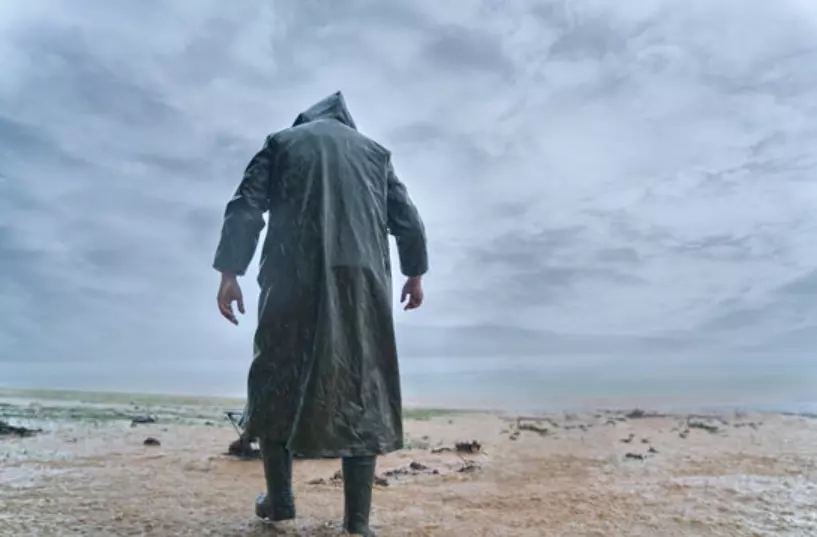
You need to understand that there’s no way to completely avoid water while camping. There’s no avoiding it, you’re going to get wet from time to time! You don’t even have to cross a river/creek, wash your clothes, or get caught in the rain. Sweat is the number one source of moisture on a camping trip.
Lets take a quick moment to talk about waterproofing sprays. Durable Water Repellent sprays (aka DWR) work on a wide variety of materials. I spray Kiwi Camp Dry on all my jackets, technical clothing, sleeping bags ETC. It really helps prevent moisture buildup on gear that’s harder to dry.
Spraying down your technical gear with waterproofing sprays will help, but you still need to learn how to dry your clothes quickly miles away from a clothes dryer. Everything that can’t be sprayed down needs to be hung up to dry. Wearing wet clothes isn’t just an annoyance, it’s also a safety issue. Wet clothing will lead to chafing, blisters, and possibly hypothermia on cold days. So how do you dry wet clothes on a camping trip?
Tip 1) Quick Dry Camping Clothes Stay Dry and Speed Up Drying Time
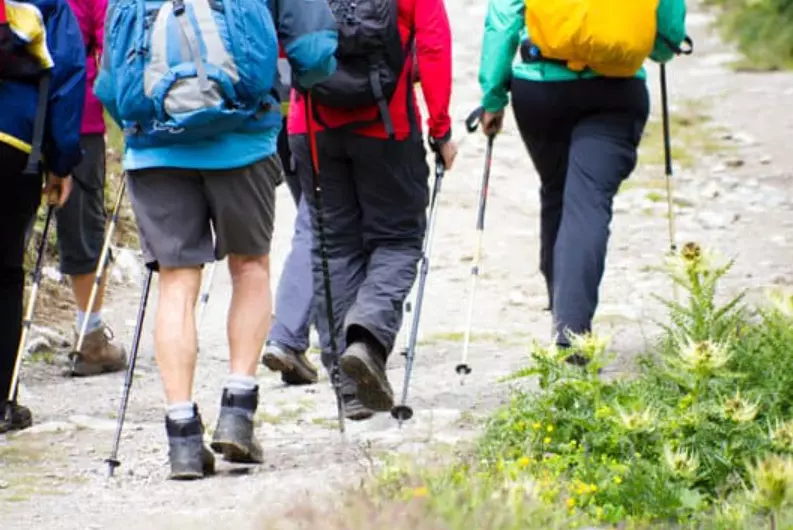
It’s important to realize that certain fabrics are going to dry faster than others. Synthetic fabrics are always going to dry faster than traditional cotton based fabrics. Most synthetic technical fabrics are called moisture-wicking or quick-dry gear.
If there’s a chance of rain consider buying ventilated rain gear and stick to synthetic moisture wicking fabrics. The key to staying dry in a rain jacket is waiting until the rain picks up to put it on. Most people put on their rain gear before they actually need it.
Rain gear should only be used in moderate to heavy rain, because it keeps out excess moisture, but it traps sweat preventing evaporation. If you’re not careful, you’ll end up covered in sweat/condensation, and wetter than if you’d kept off the jacket entirely. Rain jacket pit zips and ventilated pockets help cut down sweat/condensation, but you’ll still be damp.
Quick Dry Fabrics
Synthetic moisture-wicking shirts are obvious, but you also need to wear hiking pants, quick-dry underwear, and moisture wicking socks. Synthetic socks/underwear help, but I recommend going with merino wool. There are lots of options, but I wear Smartwool Underwear and Smartwool Socks.
Merino wool is by far the best fabric to deal with moisture buildup. It can absorb up to 35% of its weight in water without feeling wet, resists sweat/water, dries fast, prevents blisters, and feels comfortable in both cold/hot weather. You should definitely look into merino wool if you’ve ever dealt with blisters or chafing. I can’t even begin to explain how much better merino wool feels compared to synthetics and cotton.
If you’re wearing quick dry clothing, you won’t even need to take your clothes off to dry. Just keep walking down the trail and they should be dry in 30 minutes to an hour. That’s usually enough to dry sweaty clothes, but you’ll need to hang up rain soaked clothes if there’s not enough time for them to dry.
Wear Loose Clothing
Loose well ventilated clothes tend to dry faster than tight clothing. So it’s almost always better to wear a loose shirt and baggy hiking pants. Most of the time loose clothes aren’t going to get wet from sweat, but if it rains you’re out of luck. You’ll have to seek shelter or put on rain gear to stay dry.
Obviously, there are a few exceptions to that rule. You’re underwear and socks need to hug your body to prevent blisters and chafing. Wearing them loose would probably speed up evaporation, but the fabric would be constantly rubbing between your skin causing hot spots.
Alternate Clothing and Sacrificial Shirts
There’s no way to completely avoid getting wet on a camping trip. That’s why I always try to carry backups of my most important clothing. If I think that I’ll need 3 shirts I carry 4, bring a backup pair of socks, carry an extra lightweight jacket, etc.
You can also consider using a sacrificial piece of clothing or camping towel to sop off excess moisture, when you don’t have backups. If I have extra shirts I may try rolling a wet jacket in my dry shirt to sop off excess moisture. It won’t get your jacket perfectly dry, but it will be better than it was. Drying a slightly damp jacket and t-shirt together is much faster than trying to deal with a soaking wet jacket.
Tip 2) Wind and Sunlight Dries Clothes Fast!
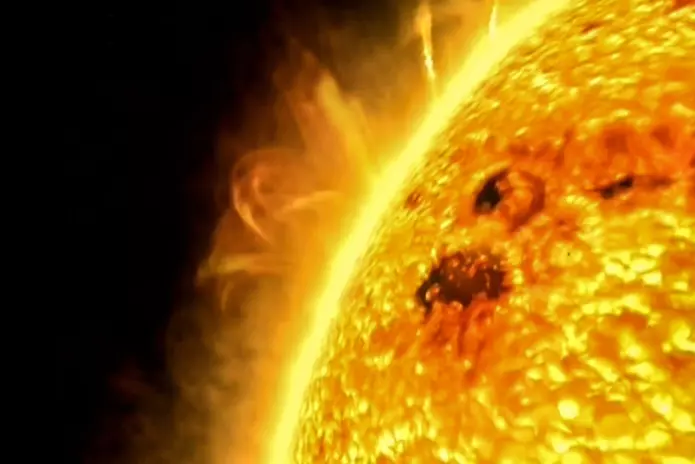
The sun is by far the most efficient heat source for drying off clothing. It doesn’t even matter if the weathers bad. You can be dealing with rainy or overcast weather and there will still be enough sunlight throughout the day to dry off wet clothes.
Just try to find as much sunlight as possible. Hang your clothes on a guy line clothesline, drape them over your tent, hang them on a tree, or just lay them out on the ground. Drying clothes on a sunny day is easy!
You should also try to use the wind to speed up drying time. Wind will blow over your clothes increasing the evaporation rate and make sure every nook and cranny dries out. Setting up your clothes line on a hill, above the treeline, and above windbreaks will increase the wind.
I’ll go over hanging up your clothes to dry in detail in the following section, but let’s talk about drying clothes in inclement weather.
Drying Clothes In Rain and Winter Weather
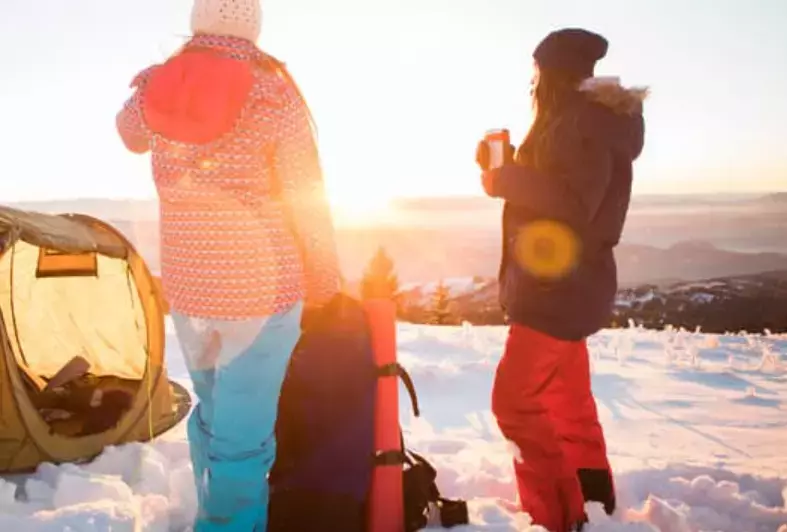
On rainy/snowy days, you can’t hang up your clothes the normal way exposing them to water. The sun/wind will still help dry your clothes, but you’ll need to create a dry area to hang up your wet clothes.
It’s actually easier to dry wet clothes in the winter. You might have to deal with stiff frozen clothes, but the dry air sucks out the moisture. Rainy days have the opposite problem, because of all the humidity. Your gear will still dry, but it will take a while.
I recommend carrying a camping tarp or tent footprint to create a dry space to hang wet clothing. When I’m expecting rain I’ll carrying a dedicated camping tarp and extra guy lines. Redcamp Waterproof Camping Tarps are cheap, lightweight, and fold up into a compact package the size of my fist.
When I get caught in the rain unexpectedly I’ll use my tent footprint like a tarp. It’s a few inches smaller than my tent floor to prevent water pooling issues, but it’s better than nothing.
Just hang up the tarp or tent footprint and run a clothesline underneath it. It also gives you a place to cook and sit outside while staying out of the rain. I like to carry a Big Agnes Skyline Ultralight chair, build a campfire just outside the tarp, and I can enjoy being outside instead of getting stuck in my tent.
Tip 3) Hang Up Your Wet Clothes
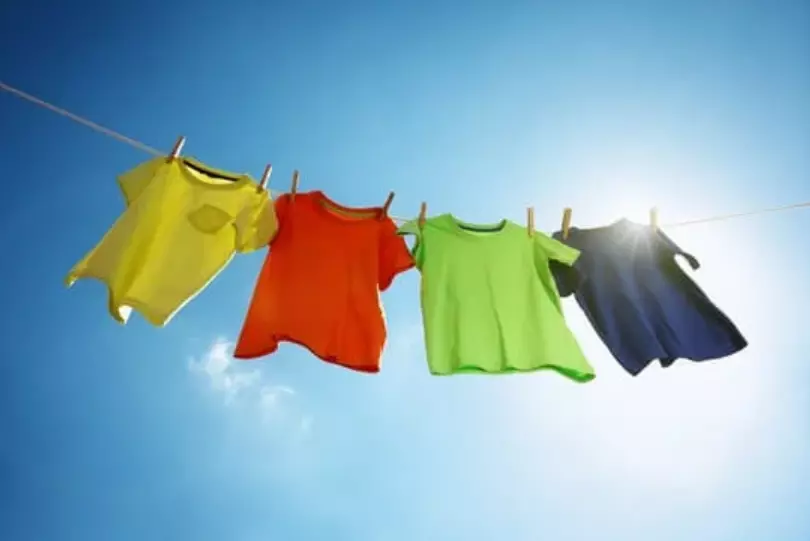
I went over hanging up your clothes briefly above, but now lets break down the hanging process in detail. Hanging up wet clothes to dry is fairly easy! How do you hang up wet clothes while camping?
- Wring Out The Excess Moisture: You can hang sopping wet clothes up on a clothes line and they’ll eventually dry, but it will take forever. It’s much faster to wring out excess moisture so you’re only dealing with slightly damp clothes.
- Maximize Wind/Sunlight: Try to find a sunny spot with lots of wind. This will significantly increase evaporation and speed up the drying process. Never use the heat from a campfire to speed up drying times. You’ll end up with burn holes all over your clothes.
- Run A Guyline Clothesline: Running a clothesline is by far the fastest way to dry clothes on a camping or backpacking trip. Find two trees with low hanging branches and run a guy line or lightweight clothesline from one branch to the other. Attach your clothes to the line and let the sun/wind do it’s job.
- Draping Clothes Over A Tent, Branch, Rock, etc.: Don’t even bother with running a clothesline if you only have one or two pieces of wet gear. Just drape them over the top of your tent, hang them on a branch, over a rock, or spread on dry ground. You should still hang up a sopping wet jacket or sleeping bag, but it shouldn’t take longer than 30 minutes to dry quick gear clothes in the sun.
- Setup A Dry Spot On Rainy/Snowy Days: You can’t just hang up your clothes on rainy/snowy days and hope for the best. You need to setup a dry spot under a tarp and hang a clothesline under it. They won’t dry as fast as they would with direct sunlight, but it’s better than nothing.
- Hang Wet Clothes On The Outside Of Your Pack: Hanging wet clothes on the outside of your pack will allow you to dry clothes on the trail. There’s limited space on the back of your pack so you’re limited to one or two pieces of clothing. That doesn’t sound like a lot, but you can dry sweaty socks or a wet shirt if you need to ever need to wash off muddy or bloody clothing on the trail.
- Dry Your Clothes While Taking Breaks: You never know if the weather will cooperate. It might rain all morning and you won’t have a chance to hang up your clothes. That’s when you need to take advantage of your breaks to dry off your clothes. I like to plan my lunch break around the weather and take extra time to dry out my wet clothes. Store all your wet gear in a dry bag at the top of your pack so it’s easy to grab and set them out whenever you take a break. Hanging clothes on a tree branch is the best option, but laying your clothes on a hot rock or even on the ground will help. Slightly damp clothes won’t take longer than 30 minutes to dry so you should be able to find time during the day.
